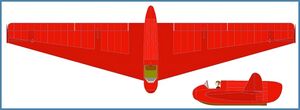Engineering:Kayaba Ku-2
From HandWiki
Short description: Japanese experimental glider
| Ku-2 | |
|---|---|

| |
| Role | Research glider |
| National origin | Japan |
| Manufacturer | Kayaba Industry |
| Designer | Hidemasa Kimura |
| First flight | October 1940 |
| Number built | 1 |
The Kayaba Ku-2 (萱場 2型無尾翼滑空機) was a glider built in Japan in 1940 to investigate the possibilities of tailless aircraft.[1] It was developed as part of an Imperial Japanese Army contract that had been offered to designer Hidemasa Kimura following the successful flights of his HK-1 tailless glider over the previous years.
Developed with the help of the Kayaba Industry's chief designer Shigeki Naito, the Ku-2 had a swept wing with two vertical fins at the end of the wings. The Ku-2 flew 262 test flights between October 1940 and May 1941 before being damaged beyond repair in a crash.
Specifications
General characteristics
- Crew: One pilot
- Length: 3.04 m (10 ft 0 in)
- Wingspan: 9.80 m (32 ft 2 in)
- Wing area: 14.5 m2 (156 sq ft)
Performance
- Maximum speed: 75 km/h (47 mph, 41 kn)
References
- ↑ Wooldridge, E. T.; National Air and Space Museum (1983). Winged wonders: the story of the flying wings. Washington, DC: Smithsonian Institution Press. p. 85. ISBN 978-0874749663.
- Wooldridge, E.T.. "Japanese flying wings". History of the Flying Wing. http://www.century-of-flight.net/Aviation%20history/flying%20wings/japan.htm. Retrieved 29 April 2007.
- 日本飞翼的短暂研究
 |

